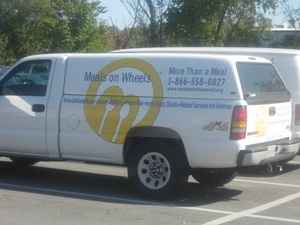Much More Than a Meal
By Kelly Medinger
11-15-2011
Meals on Wheels of Central Maryland uses human services grant to feed the hungry and homebound
Imagine if your shopping list included 1,250 lbs. of meat. Every day. That is the reality for Meals on Wheels of Central Maryland, the largest and longest continually operating Meals on Wheels program in the country.
 Feeding Those in Need
Feeding Those in Need
The central mission of Meals on Wheels is to feed those in need. Every day, more than 250 committed volunteers deliver a hot lunch and refrigerated dinner to approximately 1,500 people living in the Metro Baltimore area. These include the elderly and chronically disabled, as well as the temporarily disabled, such as those on bed rest during pregnancy or recovering from major surgery. Many times, the client’s only social contact outside the house is the Meals on Wheels volunteer who comes to visit each day during the week.
Fostering Life-Saving Relationships Between Volunteers and Clients
In fulfilling its core mission, Meals on Wheels is often so much more than just a conduit for sustenance – it’s a lifeline to the homebound. On Labor Day this year, a Meals on Wheels driver was delivering lunch and dinner to a woman living at home in a wheelchair. When he arrived at her house, she did not answer the door, and he could hear her crying out for help from inside the house. She had fallen out of her wheelchair on Saturday, and when he found her on Monday, she had gone 48 hours with no food, no water, and no ability to move or reach a phone to call for help. “The sad truth is that she probably would have died there, had it not been for Meals on Wheels,” relates Barbara Levin, Client Services Director.
“The volunteers and clients become quite attached to each other,” explains Ellen Falk, Volunteer Retention and Recruitment Coordinator. Volunteers often shop for clients, bring in their mail, take out the trash, and talk to them about their families. After excitedly telling clients about her daughter’s upcoming wedding, one volunteer brought her daughter and the wedding pictures on her route to share with clients. Then there is the exceptionally dedicated gentleman who volunteers all five days a week. He recently retired, and his wife of nearly 60 years told him he “needed to get out of the house and find something productive to do with his time.” Thank goodness for Meals on Wheels!
Starting in the Kitchen
Yet the good work that Meals on Wheels does out in the community starts inside the warehouse kitchen. In 2010, the Knott Foundation awarded a grant to meet a funding challenge from the France-Merrick Foundation, which enabled the organization to purchase a Cook-Chill System.
This impressive piece of machinery cooks large quantities of food and then chills it immediately. Meals on Wheels uses it to cook almost anything, most recently discovering that it is both cheaper and healthier to cook beans in the Cook-Chill System instead of purchasing the higher-sodium canned varieties. “And the best part is,” shares Kathleen Tinker, Food Services Manager, “the system can even cook overnight when no one is here.”
Meeting Ever-Growing Needs
Even with these advances, Meals on Wheels is still faced with the daunting task of meeting growing needs. With the aging population, the organization is projecting an explosion of demand over the next ten years. “The goal is to double the number of clients served by 2020,” states Toni Gianforti, Grant Writer.
The Cook-Chill System is one way they are increasing their capacity to produce more meals. Another way is through a new tray sealing process, funded by a $100,000 grant from The Walmart Foundation and the Meals on Wheels Association of America. Notably, the grant required a quick turnaround of a 10% match, and the Knott Foundation provided the initial $1,000, with the Board pledging the remaining $9,000. “The Knott Foundation provided the weight and leverage we needed to secure the rest of the funds,” Gianforti adds.
Thus, with an impressive history in Maryland and an ambitious charge for the future, Meals on Wheels continues to help homebound people eat well, live independently, and enjoy peace of mind.
